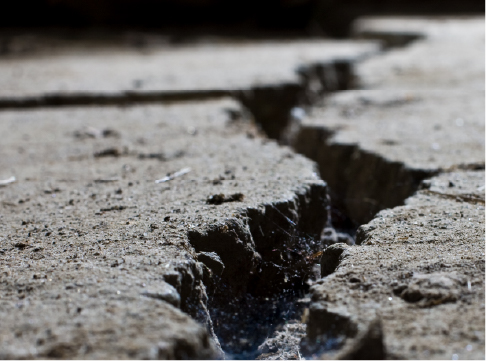When you turn on your tap to fill a glass with water, enjoy a shower, or wash clothes, chances are that this water came from a nearby water tank before being piped into your home. In addition to residential and business water needs, storage tanks also provide water pressure to supply fire hydrants for firefighting needs.
Our community would depend on the available stored water should an emergency, like a spill on the McKenzie River or equipment failure at the filtration plant, disrupt supplies. EWEB currently has enough storage to provide a few days of drinking water to the community in an emergency.

Improving earthquake resilience
There's always the possibility that a natural or human-caused disaster could affect us here in the Pacific Northwest. The most significant hazard that could affect EWEB facilities is a Cascadia Subduction Zone earthquake.
The Cascadia Subduction Zone is a long fault that extends from along the coast from Vancouver British Columbia to Northern California. The fault separates the Juan de Fuca and North American Plates. It is called a subduction zone because the Juan de Fuca plate is moving under (subducting beneath) the North American Plate. At this point of subduction, a magnitude 9.0 earthquake can result, similar to those seen in recent years in Japan and Chile.
Research indicates there is a high probability the Cascadia Subduction zone will result in a magnitude 9.0 earthquake within the next 50 years. While we are located far inland of the fault, an earthquake of this size will cause significant damage to our water system that could take months to fully repair. Distribution and transmission pipes can rupture during sudden ground movement. A substantial seismic event could also affect intake structures that bring water from the McKenzie River to the filtration plant, as well as tanks that store millions of gallons of water throughout the community.
Improving earthquake resilience requires investment in our community's infrastructure, including:
- Replacing old water mains
- Upgrading or building water storage tanks
- Adding back-up power to pump stations
- Making seismic upgrades at the Hayden Bridge Water Filtration Plant
- Planning for a new water treatment plant on the Willamette River built to modern seismic standards
Building a more resilient water system requires careful financial planning to balance infrastructure needs with affordability. We are addressing the work in phases to help manage costs over time. We started with seismic retrofits and modernization projects at the Hayden Bridge filtration plant and are completing resiliency work there. While we will continue to replace water mains and upgrade pump stations, the next major phase of investment involves water storage systems.
Water storage improvement projects
EWEB's water distribution system includes 22 storage tanks to deliver drinking water to area homes and businesses. The majority of Eugene residents rely on water stored in base-level water storage tanks at College Hill, Hawkins Hill and E. 40th, which thanks to a consistent elevation of 607 feet, use gravity to transport water to Eugene's network of pipes without relying on electric pumps.
These base-level water storage tanks are the backbone of a water system that serves nearly 200,000 people. These facilities must remain operational after an earthquake in order to meet critical community needs, including fire suppression, public health, and emergency drinking water supplies, while repairs are being made to the distribution system.
Third-party assessments have found that the College Hill and Hawkins Hill water tanks are unlikely to survive a major earthquake, meaning they could not be relied on to supply safe drinking water, or could fail completely. The assessments also show that upgrading these facilities is neither cost-effective nor practical in the long run. They would require significant retrofitting and expensive maintenance as they continue to age, and even after these investments, would still be vulnerable to earthquake damage.
To safeguard our community's water supply, EWEB built two new earthquake-resilient water storage tanks near E. 40th and Patterson St. which will enable the utility to drain and rebuild the College Hill and Hawkins Hill tanks to modern seismic standards.
Once complete, Eugene's water storage will be able to better withstand natural disasters and protect public health, making Eugene a livable, and thriving community for generations to come.
Here are some of the design and engineering features that make Eugene's newest base-level drinking water storage tanks safe, reliable, and earthquake-proof:
1. Elevation of 607 feet allows gravity to transport water to the network of pipes without relying on electric pumps.
2. Two smaller tanks instead of one large one provides redundancy.
3. Heigh and roof designed to withstand seismic-induced slosh waves.
4. Tanks are constructed out of reinforced, pre-stressed concrete to achieve a high load capacity both laterally and vertically.
5. Each tank is wrapped in 90 miles of high-strength steel wire, which is then encased in shotcrete.
6. Flexible pipe couplings have double-ball joints that can move in every direction.
7. Secure fencing protects water from contamination, vandalism, and other threats.
8. Anchored flexible base connection between the floor and wall allows load transfer in a seismic event.
9. Remotely operated seismic valves can isolate the tanks from the distribution system downstream.

